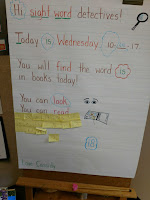
On Friday, children wrote notes to some of our families, thanking them for volunteering this past week. As we continue to receive incredible snack and book donations, the children expressed an interest and desire to write notes to the many important members of our community! We talked about how writers think about their audience. For example, many of the children were writing notes to Jen, Katie, and Ben for teaching us about seeds and how seeds travel. We talked about what you might draw or write on that note - what would you write or draw for the audience? Seeds!
What about for Anne, following our yoga and movement experience? Children shared that you could draw all of us doing yoga on our blue alphabet rug!




Another way children develop important literacy skills, is engaging in book conversations and reflections. On Friday, I shared with the children two math poems. In the morning, before introducing the poems, I asked the children, what is poetry? Many children said that they've heard the word before, but that they weren't sure what it was. I shared with them that we would be reading a special poetry book given to our classroom later in the day, but that I was curious about what they knew.
Some of their thoughts about poetry;
IM- Poetry can be silly.
ML - Poetry rhymes.
DM - Poetry can have numbers in it. You find it in books.
Later in the day, I read the book, Daniel Finds a Poem. It is a beautiful story of the character, Daniel, in search of the meaning of poetry. As he asks each creature in his beloved park what poetry is, he learns that poetry is all around us. Following the read aloud, I asked the question, what is poetry to you?
ML - To me, poetry is being with my community. Going with my family to Martha's Vineyard.
JF - Poetry is going in the woods with my friends and Ms. Cassidy. Going far away.
OM - Jumping in a pool!
KS - Going in the woods with my dad and feeling the nice sun on my head.
GK - Poetry is water parks.
IM - Poetry is sitting in a quiet room.
KC - Poetry is going on a lazy river and feeling the breeze.
TW - Poetry is jumping. Jumping in a pool!
DM - Having fun.
AM - Poetry is going on a hike.
WM - Poetry is having fun.
CM - Poetry is having fun together in Kindergarten.
TJ - Poetry is finding toads, newts, and snakes.
ZM - Going down a slippery slide.
EO - Going to Montreal with my family.
OC - Poetry is being with my friends in Kindergarten. And going on trips to Burton Island with my family.




















































